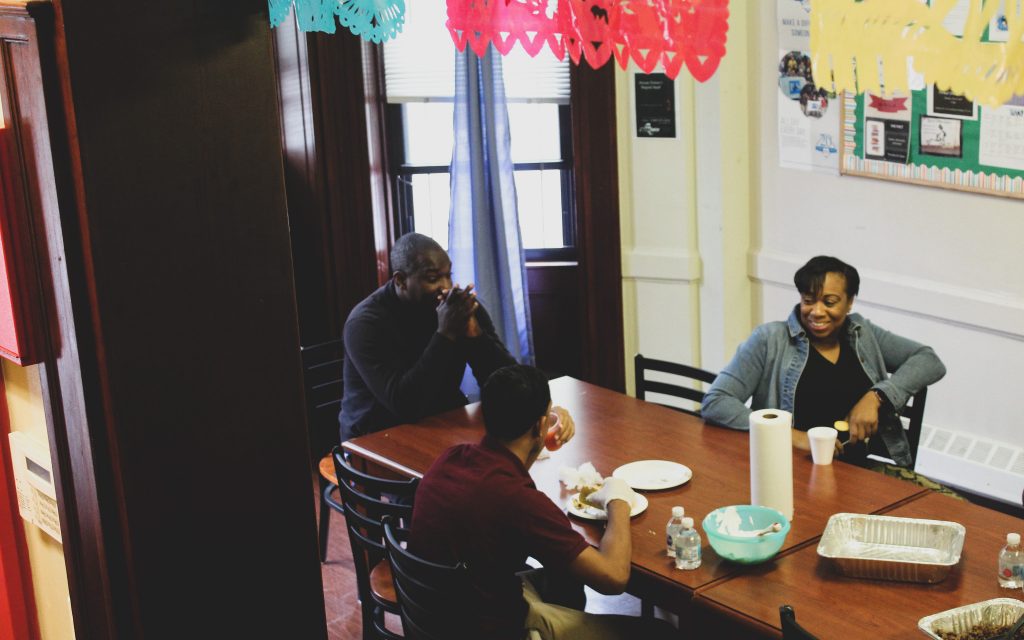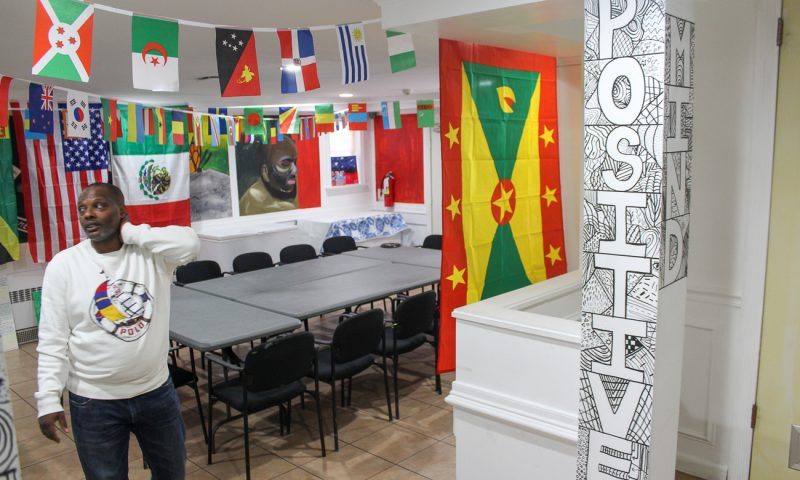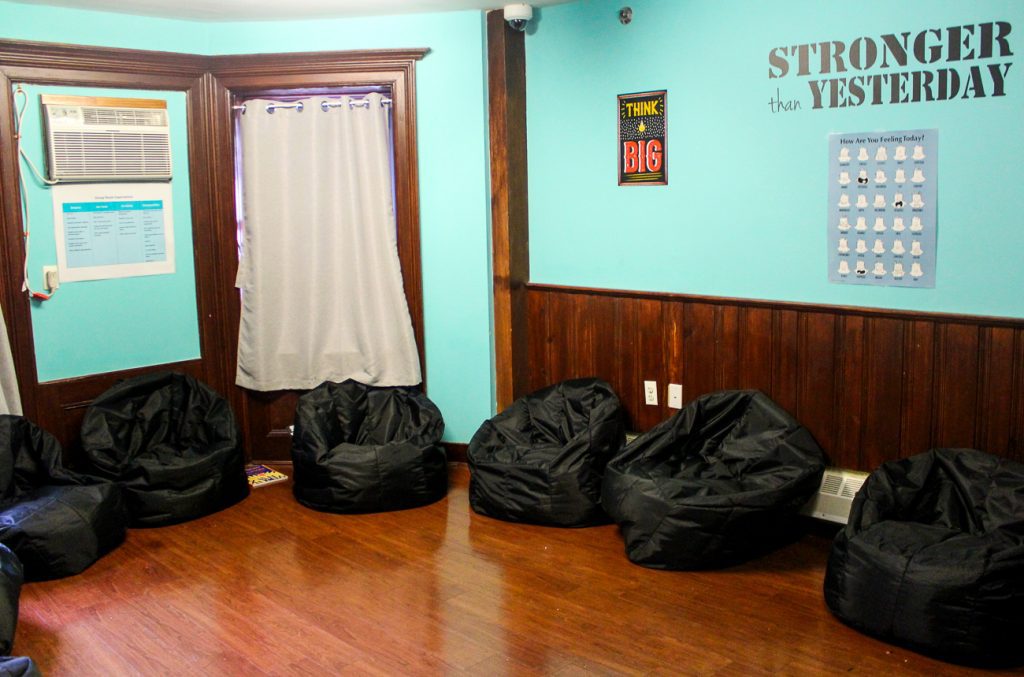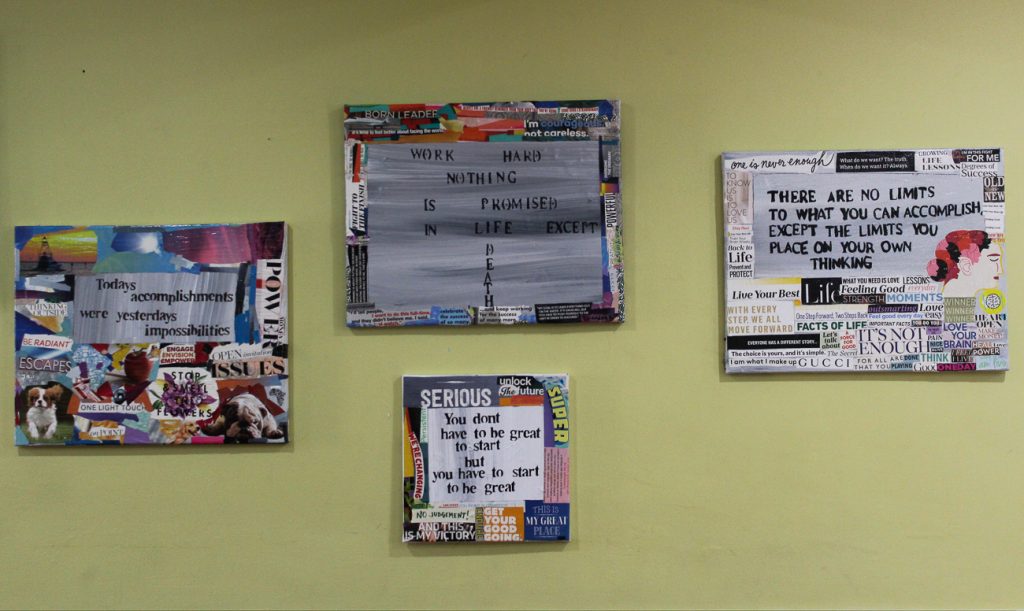Building Trust Can Help Juvenile Offenders
How Milwaukee can learn from juvenile offender programs in NYC. Second in series.

Youths eat lunch with staff members at a big family-style kitchen table at a limited-secure Close to Home facility in Brooklyn, New York. Photo by Allison Dikanovic/NNS.
Four teenage young men stand in a circle around a long wooden dining room table. Staff members, some of whom wear polo shirts and on-trend khaki pants with elastic around the ankles—matching the kids’ attire—stand in the circle as well. Colorful tissue paper decorations hang from the ceiling, and taco toppings are spread out on the table ready for lunch.
After waiting for their court date in a more traditional detention center, the young men around the table were placed in this Close to Home facility in Brooklyn operated by the nonprofit Rising Ground. It is one of the small facilities for six to 12 kids that replaced the state’s youth prisons, and it’s meant to resemble a homelike environment. The idea is a shift from the traditional idea of “corrections” to make the space and program less punitive and more constructive, said Lisa Crook, vice president of justice for youth and families programs at Rising Ground.
Before sitting down for lunch, each person completes the sentence out loud, one after the other, “I’m checking in and I’m feeling … ”
“Blessed.”
“Relaxed.”
“Focused.”
“Shy.”
“Sad.”
Someone intercedes, “Do you want to talk about it?”
“No.”
The circle continues.
“I’m checking in, and I’m feeling optimistic.”
No one skips a beat, a sign the youths obviously are familiar with the practice.
This type of check-in and open discussion about feelings is an integral piece of the model of care this home embraces, Crook said. They follow what’s called the Missouri Model. The model focuses on building trust and accountability between youths and staff and relies heavily on group therapy. Anyone, staff or youths, can call for a “circle” at any point throughout the day if they want to talk a situation through or check in as a group.
In order to get a contract from the city’s Administration for Children’s Services to run a Close to Home facility, provider organizations such as Rising Ground are required to have a specific, evidence-based model of care that guides their work. The providers say this has contributed to their homes’ success, but leaders from some grassroots organizations counter that these types of stipulations have become a barrier to smaller, locally trusted organizations that seek Close to Home contracts.
Felipe Franco, the deputy commissioner of New York’s Administration for Children’s Services, said the point of this requirement is to have a unifying philosophy so all staff and youths work within the same structure.

Edwidge Michel shows the different flags on display in the Close to Home facility in Queens, New York, as part of a cultural celebration the youths held for a family engagement event. Photo by Allison Dikanovic/NNS.
‘We work on being nonjudgmental’
After their circle, the young people took their seats and goofed around at lunch, laughing with staff.
Earlier this year, Nathan, 13, spent about seven months at a different Rising Ground Close to Home facility in the Bronx that operates similarly to this one in Brooklyn.
He said his relationships with staff made all the difference for him while in Close to Home. Nathan was placed there after multiple incidents of robbery.
“I mean nobody wants to be locked up, but staff made days better and stuff,” he said. “Staff made it feel like home sometimes, even though I still knew that it was not the crib.”
Crook said a quality staff that youths can genuinely relate to is essential to the success of the Close to Home model.
“The kids will be the first to tell you if a staff member is just in it for a paycheck,” she said. “The kids can read through your BS in like five seconds.”
Crook said many staff members come from the neighborhoods where the homes are located and where the youths are from. Many have had experiences in the system themselves or have faced similar circumstances like the young people they supervise. Staff members know the major events and the always- changing nuances of the neighborhoods—including gang dynamics.
“The kids know our staff are coming from a lot of the same places and have experienced a lot of the same things, and they can see, ‘Oh, there’s a different path. I don’t have to hang out on the streets,’ Crook said. “That’s huge, and kids weren’t getting that when they were in Buffalo or Syracuse or wherever they were before.”
Edwidge Michel, a group leader for a Close to Home facility in Queens, which is run by a different provider, said the role of staff in these programs is “not correctional.”
“It’s not being a security guard,” Michel said. “You’re actually constantly being therapeutic with a young person and trying to have a breakthrough or even plant seeds of hope so they can move on and be successful.”
Crook and Michel said both homes focus heavily on training staff on how to best speak to youths and how to manage their own emotions while on the job.
“We are respectful of what the young people have to say and understand that emotions are not wrong or right,” Michel said. “We work on being nonjudgmental.”
This perspective is necessary for building positive relationships, but also for maintaining a safe community within the home, Crook explained.
It’s a concept Franco described as “safety by relationships.”
Sometimes subtle things can be perceived as a threat and could make a young person feel unsafe, on guard or combative, Crook said, but knowledgeable staff pick up on those things.
“If a young person doesn’t feel safe, they’re either going to fight or flight,” Michel said. “We want them to think, ‘I don’t have to worry about safety, so I can now focus on treatment.’”
Nathan agreed.
In limited-secure homes such as this one, school is provided in-house, but in most of the Close to Home facilities, which are “non-secure,” the youths attend a special school offsite. In both cases, the New York City Department of Education runs the schools, so all of the young people’s credits transfer to whichever school they attend when they return to the community. Most youths stay in a Close to Home facility for just under a year, followed by court-ordered aftercare programming.
“I didn’t have to be ‘on’ when I got here,” Nathan said. “It takes me a long time to trust people, but I didn’t have to come in with my guard up.”
Building a community
Each night, the youths meet in a room lined with black leather bean bag chairs and inspirational quotes affixed to the turquoise walls for “group.”
This regular therapy meeting is the heart of the model of care, where the young people process their emotions and decision-making through daily reflections, discussions and activities in community with each other.

Bean bag chairs line the room where group therapy sessions are held in the Close to Home facility in Brooklyn, New York. Photo by Allison Dikanovic/NNS.
“The positives I got from placement were learning how to control my frustrations and becoming more patient,” Nathan said. “I was not a patient kid. I wanted things when I wanted them. That slowed me down, being in there. Maybe not slowed, but it calmed me down.”
Bryson, 15, and Antoine, 14, were staying in the Close to Home facility in Queens run by Michel, and they said that group provides an opportunity for them to learn from each other.
“It’s a good environment, an open space. We can talk about anything, different topics,” Bryson said. “Like if anything is a concern, we can speak about it and know how to fix it and put it into play a different way. The most important thing is that everybody respects each other and respects the feelings.”
After group, the youths can make phone calls home or to loved ones. The length and frequency of the calls is a privilege that’s incentivised in the program. Youths can earn more or longer calls with excellent behavior.
Nathan said this helped him stay motivated.
“You earn stuff, so then I had something to lose,” he said. “When you’re locked in, you don’t have anything to lose. If they’re not talking about sending you home, if they just set your court dates back and stuff, you’re just going to give up. You’re not going to care.”
The same approach applies to home visits.
As youths progress through the program, they can earn time away from the facility and with their families, ranging from a few hours to a whole weekend.
“I was seeing my family more often,” Nathan said. “That’s what I’m saying. I had something to lose.”
Youths just starting the program and youths in the “limited-secure” homes don’t get to leave the facilities, but their families can visit them at least once a week.
Most of the homes are easily accessible by public transit, but if a family has transportation troubles, the provider organizations will pick bring them there.
The Close to Home facilities also hold regular family events and celebrations, such as a dinner party where the youths cook for their families or an art gallery night where they display their work.
Crook said the goal is for youths to feel they are still an important part of their family and community, even if they’re not living at home at the moment.

Youths’ art projects adorn the walls in the Close to Home facility in Queens, New York. Photo by Allison Dikanovic/NNS.
In the evenings and on the weekends, different homes have activities that are built into their programming, ranging from book clubs, yoga, cooking classes, basketball and movie nights to hatching chickens, hydroponic growing, music lessons at Carnegie Hall, kickboxing or indoor skydiving.
‘You’re still addicted to locking up kids’
Though advocates say Close to Home programs create positive experiences for young people, some are wary that they are still too similar to past models of youth incarceration.
Ruben Austria started an organization called Community Connections for Youth right around the same time that the Close to Home initiative was beginning. He was an advocate who pushed at a statewide level to close New York’s youth prisons and to ensure resources were invested in community programs in areas like the South Bronx.
Austria said he often thinks that New York could do more to invest in the neighborhoods, families, programs and communities that surround the kids who end up in the system.
“We’re not doing the most punitive and harsh thing, but we’re also not really investing in communities except in the way of brief treatment and temporary supervision,” he said.
Austria said Close to Home “was both an excellent development and also a huge missed opportunity in certain ways because of the absence of a community capacity-building strategy.”
He warned places like Milwaukee not to miss the opportunity.
“People get too caught up on ‘Well, where are we going to put the kids?’ and end up creating just a kinder, gentler reincarnation of youths incarceration,” he said.
Austria said investing in a young person’s neighborhood, family and community will produce the most positive outcomes.
“You might spend millions of dollars on architects and designing the new facilities, but how much are you spending designing and developing the alternatives? You’re still addicted to locking up kids,” Austria said. “It’s just a question of priorities.”
This story was originally published by Milwaukee Neighborhood News Service, where you can find other stories reporting on eighteen city neighborhoods in Milwaukee.
More about the Lincoln Hills and Copper Lake Facilities
- Evers’ Prison Plan Receives Mixed Reviews - WPR Staff - Feb 21st, 2025
- ‘First of its Kind in Wisconsin’ Collaboration Will Support Disabled Incarcerated Youth - Andrew Kennard - Dec 12th, 2024
- MKE County: Tight Budget Forces Difficult Vote on Housing, Juvenile Justice - Graham Kilmer - Nov 1st, 2024
- Letters from Evers, Republicans Show Clash on Juvenile Corrections - Andrew Kennard - Aug 17th, 2024
- Following Counselor Death, Staff, Family Plead for Help At Lincoln Hills - Andrew Kennard - Aug 16th, 2024
- Lawmakers Grill Wisconsin Prison Officials Over Safety, Employee Death at Youth Facility - Sarah Lehr - Aug 7th, 2024
- Future of Lincoln Hills Remains In Limbo - Isiah Holmes - Apr 12th, 2024
- MKE County: County Youth In State Prisons Declining Again - Graham Kilmer - Jan 15th, 2024
- Legislative Committee Okays $6 Million for 2nd Juvenile Facility - Devin Blake - Oct 1st, 2023
- Some Progress, Still Problems at Lincoln Hills - Isiah Holmes - Jul 9th, 2023
Read more about Lincoln Hills and Copper Lake Facilities here
Close to Home
-
New York’s After Care Program Helps Youth
 Sep 17th, 2019 by Allison Dikanovic
Sep 17th, 2019 by Allison Dikanovic
-
How New York Handles Juvenile Justice
 Sep 10th, 2019 by Allison Dikanovic
Sep 10th, 2019 by Allison Dikanovic





















